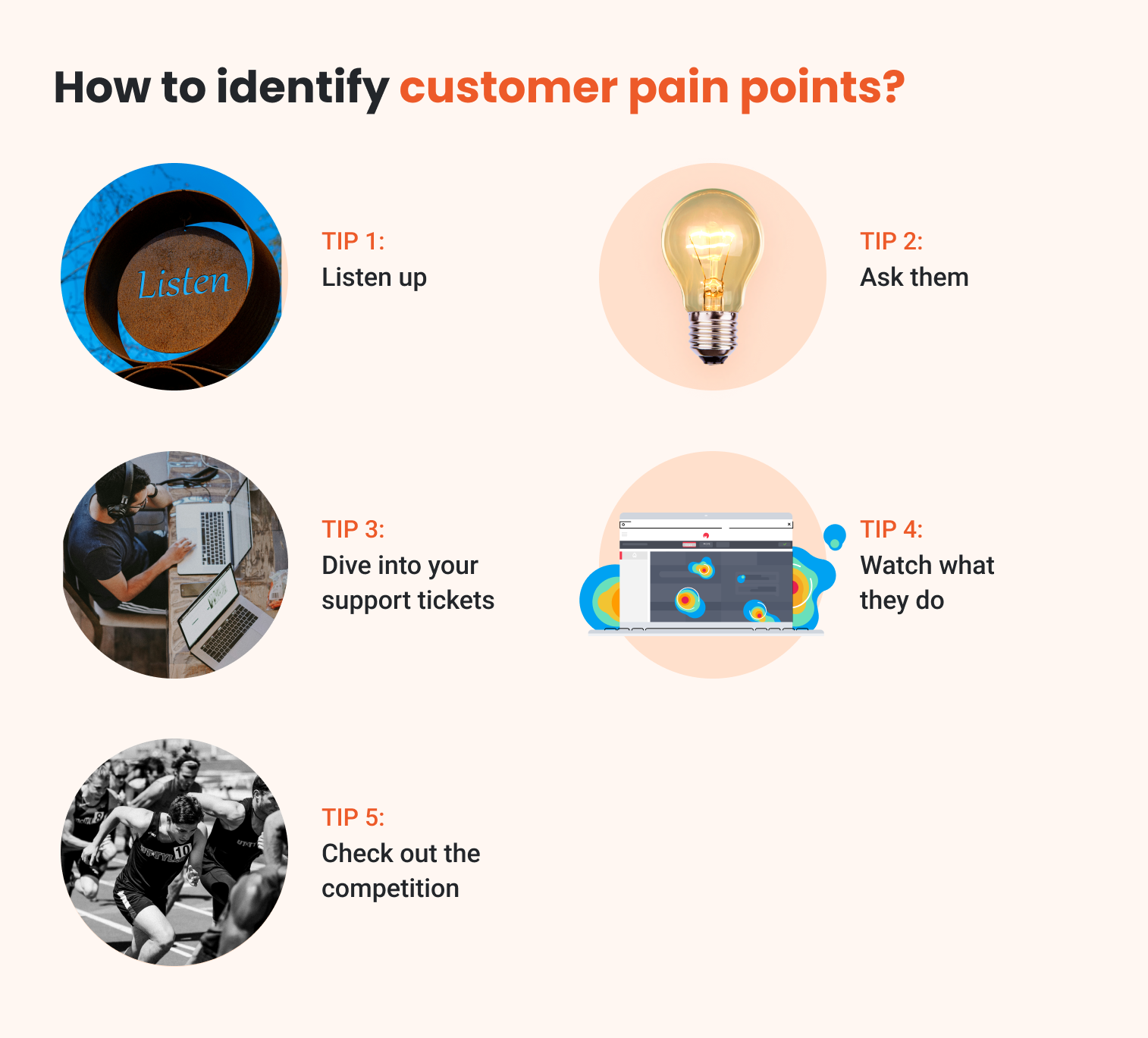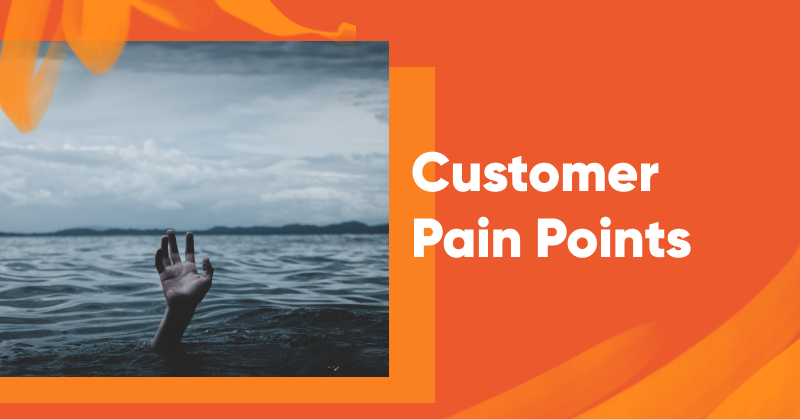In this article, we’ll dive into the world of customer pain points in sales—the things that make your customers go “Argh!” when they’re trying to buy from you.
Understanding your prospect’s pain points isn’t rocket science. It’s about getting inside their heads and figuring out what’s making them grumble.
Once you’ve got a handle on that, you can use it to supercharge your sales strategy.
What are customer pain points?
Ever wonder what bugs your customers the most? That’s what we call customer pain points.
Customer pain points are essentially the obstacles that get in the way of customers feeling happy and content. These can be about spending too much cash, wasting time, or dealing with something too complex. Sometimes, it’s just about wanting something better than what they’ve got.
Understanding your customer’s pain points is super important for businesses.
Why? Because knowing what makes your customers tick (in a bad way) lets you step in with a solution.
It allows you to tailor your marketing messages, product development, and customer service strategies to directly answer the needs of your customers.
In doing so, you position your business as the solution they’ve been searching for.
Think of it as your secret sauce to boost sales by being the fix they’ve been looking for.
How to identify customer pain points?
Now that you know what are customer pain points and why are they so important, it’s time to figure out what’s bugging your customers.
Here’s the lowdown on how to spot your customers’ pain points.

1. Listen up
The easiest way to identify customer pain points is by paying attention.
Check out what people are saying online, like in reviews or social media. People don’t hold back there, so you’ll get the real deal on what’s annoying them.
2. Ask them
Sometimes, the direct route is the best. Just ask your customers what’s bothering them.
Use surveys, feedback forms, or just a simple chat. It’s like asking, “Hey, what can we do better?”
Here are some survey templates that you can use:
3. Dive into your support tickets
Your customer support teams are a goldmine of info. Look at the complaints or questions people have. Spotting trends? Those are your customer pain points.
4. Watch what they do
Actions speak louder than words, right?
See how customers use your product or website. If they’re getting stuck somewhere or avoiding something like the plague, you’ve found a pain point.
Use tools like HotJar to see where & why visitors drop off before converting.
5. Check out the competition
See what people are saying about your rivals. If there’s something they’re loving elsewhere that you’re not offering, that’s a customer pain point you didn’t even know you had.
Identifying customer pain points is about getting down to what your customers really need and want. Once you know what’s rubbing them the wrong way, you can start making the customer experience a whole lot smoother.
Pain point examples
To understand customer pain points better, let’s dive into some real-life pain point examples that businesses commonly encounter. Think of these as the usual suspects.
1. High costs
Everyone’s wallet feels a bit tight sometimes. If people feel they’re paying too much for what they’re getting, or if they see a better deal elsewhere, that’s a big ouch on the price front.
2. Time-consuming processes
Time’s precious, and nobody likes to waste it. Waiting too long for a product to arrive, spending ages on hold, or navigating a confusing website can make customers wish they were elsewhere.
3. Poor customer service
Rude staff, unhelpful support, or just feeling ignored can turn a loyal customer into a one-time visitor. Good vibes are key, and bad service is a surefire way to spoil the mood.
4. Product limitations or poor quality
Customers feel disappointed when products fall short of their expectations or lack essential features. When what you get isn’t up to snuff, it’s a bummer. Whether it’s a gadget that breaks down too soon or a shirt that looks nothing like its picture online, poor quality is a major letdown.
5. Lack of transparency
You’re interested in a subscription service, but you can’t find clear information about cancellation policies or hidden fees. It’s like trying to navigate through fog! Customers crave transparency and honesty from businesses to make informed decisions.
6. Complexity
Ever felt like you need a degree to figure something out? Products that are too complicated, instructions that make no sense, or processes that take too many steps can frustrate anyone.
Recognizing these customer pain points in your own business isn’t about feeling bad. It’s your chance to step up and fix things.
Turning a pain point into a strong point can make your customers happier and more likely to stick around. Plus, it’s a solid move for boosting your sales and reputation.
Pain points and emotional triggers
Emotions play a significant role in shaping the customer journey. Behind every customer pain point lies a story filled with emotions.
Businesses that prioritize empathy and understanding in their approach to addressing customer pain points are better equipped to foster genuine connections with their audience.
Let’s take a look at the possible emotions.
- Frustration: When customers encounter obstacles or inefficiencies, frustration often sets in. It’s like hitting a roadblock when you’re in a hurry. You need to recognize these moments of frustration and work to alleviate them swiftly.
- Disappointment: Imagine eagerly anticipating a product or service, only to find it doesn’t meet your expectations. Disappointment creeps in, tarnishing the customer experience. Addressing areas where customers feel let down is essential for maintaining their trust and loyalty.
- Anxiety: Uncertainty breeds anxiety. Whether it’s concerns about hidden costs, unclear policies, or the reliability of a product, customers don’t want to feel like they’re taking a gamble. Providing transparency and reassurance can help ease these anxieties.
- Anger: Poor customer service or product failures can ignite anger in even the most patient individuals. When customers feel ignored or mistreated, they’re likely to vent their frustrations publicly. You must address these issues promptly and empathetically to prevent further escalation.
- Satisfaction: Conversely, resolving customer pain points can evoke feelings of relief and satisfaction. It’s like finally untangling a stubborn knot. By actively listening to customer feedback and implementing solutions, you can turn negative experiences into positive outcomes.
4 tips for addressing customers' pain points
Once you’ve identified your customers’ pain points, it’s time to roll up your sleeves and tackle them head-on.
Here are four tips to help you address those pesky business pain points and turn them into opportunities for improvement.
1. Prioritize solutions
Once you’ve identified the pain points, prioritize them based on their impact on the customer experience and business objectives.
Focus on resolving the most critical issues first to deliver immediate relief to your customers.
2. Implement clear communication
Transparency is key to building trust with your customers.
Clearly communicate how you’re addressing their pain points and what changes they can expect to see. Keep them informed every step of the way to avoid any surprises.
3. Iterate and improve
Uncovering customer pain points and addressing them is an ongoing process.
Continuously gather customer feedback, monitor changes, and iterate on your solutions. Be open to refining your approach based on new insights and evolving customer needs.
4. Empower your team
Equip your customer-facing teams with the tools, training, and authority they need to address pain points effectively.
Encourage a customer-centric mindset across your organization including sales teams, customer support teams, and marketing teams, and empower each employee to take ownership of customer satisfaction.
Wrapping up
Understanding and leveraging your business pain points can significantly improve your sales strategy and overall business success.
By identifying these pain points, whether they stem from high costs, time-consuming processes, poor customer service, product limitations, lack of transparency, or complexity, you gain valuable insight into your customers’ needs and desires.
Armed with this knowledge, you can tailor your marketing messages, product development, and customer service strategies to directly address these pain points, positioning your business as the solution they’ve been seeking.
Furthermore, recognizing the emotional triggers behind these pain points allows you to empathize with your customers and foster genuine connections. Whether it’s frustration, disappointment, anxiety, or anger, acknowledging and alleviating these emotions can lead to increased satisfaction and loyalty.












